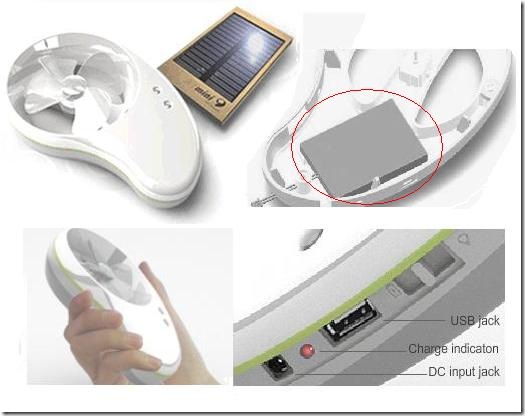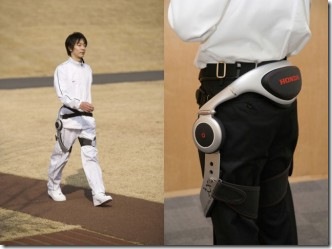
I walk along the Beach on the rare cloudy day, listening to the portable media player as I keep an eye out for things to wash up from the Cyber Sea. After a while my media player stops playing, thanks to me forgetting to charge it recently. Luckily I had the small wind turbine strapped to my arm, and with the gentle wind blowing off the surf today it has been fed the whole trip, whereas my usual solar panel arrangement would not have fared so well. I stop to hook up the media player to the small wind unit, getting a charge off of the built in charging battery. After a few minutes I continue on my way, listening courtesy of wind power.
The Green, ecologically friendly HYmini portable wind charger is a small handheld wind turbine with a built in rechargeable battery. The unit, when in a wind of 9mph or more, will charge its 1200 mah battery, storing the charge for later use. The small (5.4in high, 3.4in wide and 1.3in deep) should fit in about any hand or average pocket, allowing for easy travel. There are bike and human arm mounts available for the device, and for when the wind is not blowing (like on a bright, calm sunny day), there is a small solar panel that can hook to the unit and charge its battery.
If you are curious about how much wind your city typically gets you can check this on the chart here, but surprisingly a lot of places will be able to provide the wind power needed to charge your device. According to the HYmini website you can get enough power from 20 minutes of wind to power an iPod for 30 minutes or a PDA for 40 minutes (too bad they don’t break it down to actual energy produced numbers, but that should give you a good ideal of its capability). Teamed with the Solar panel, this would seem like a good combination of green replenishable power to charge your small electronic devices in all seasons.
You can also find a similar device, the K3 Wind and Solar charger, on Amazon. This unit is listed as being durable and wetherproof, with an internal battery that will charge an iPhone 5 times before running out of reserve power.


 It is a beautiful sunny morning, and I breathe deep, enjoying the feel of the air expanding my chest. I strap on the lightweight robotic exoskeleton (a recent find from the Cyber Sea) and start the climb on the cliffs close by the surf. After about an hour into the effort, I stop to look out to sea, marveling as always the way the curve of the flat horizon shows how small of a planet we live on. I still feel fairly fresh, thanks to the mechanical assist from the device. I figure I have about an hour of charge left, so I plan on using the lightweight exoskeleton for the climbing up portion of my little adventure this morning. The coming back down part I can manage just fine on my own.
It is a beautiful sunny morning, and I breathe deep, enjoying the feel of the air expanding my chest. I strap on the lightweight robotic exoskeleton (a recent find from the Cyber Sea) and start the climb on the cliffs close by the surf. After about an hour into the effort, I stop to look out to sea, marveling as always the way the curve of the flat horizon shows how small of a planet we live on. I still feel fairly fresh, thanks to the mechanical assist from the device. I figure I have about an hour of charge left, so I plan on using the lightweight exoskeleton for the climbing up portion of my little adventure this morning. The coming back down part I can manage just fine on my own.